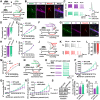Kv1.1 channel dysfunction in parvalbumin-positive interneurons contributes to anxiety-like behaviors in young adult presenilin 1/2 conditional double knockout mice
- PMID: 40563122
- PMCID: PMC12199491
- DOI: 10.1186/s13578-025-01422-w
Kv1.1 channel dysfunction in parvalbumin-positive interneurons contributes to anxiety-like behaviors in young adult presenilin 1/2 conditional double knockout mice
Abstract
Anxiety occurs in the early stage of cognitive disorders, which can exacerbate cognitive impairment. However, the pathogenesis of this kind of anxiety remains unclear. In this study, we investigated anxiety-like behaviors in young adult presenilin 1/2 conditional double knockout (PS cDKO) mice, a model of progressive cognitive impairment, using behavioral tests and electrophysiological recordings. Disrupted excitatory/inhibitory (E/I) balance was observed in pyramidal neurons (PNs) of the ventral hippocampus (vHPC) CA1 (vCA1) region of PS cDKO mice. Meanwhile, PV + interneurons showed hypoexcitability, associated with increased outward K+ currents due to elevated Kv1.1 potassium channel levels. Importantly, genetic or pharmacological inhibition of Kv1.1 restored PV + interneuron activity and reduced anxiety-like behaviors. These findings highlight a role of Kv1.1 in controlling PV + interneuron excitability, suggesting that targeting Kv1.1 in vCA1 PV + interneurons could mitigate anxiety in early-stage cognitive dysfunction.
Keywords: Anxiety; Cognitive disorder; Excitatory/inhibitory balance; Kv1.1; Parvalbumin-positive interneurons.
© 2025. The Author(s).
Conflict of interest statement
Declarations. Ethical approval: All animal procedures were conducted in strict accordance with the Guidelines of the National Institutes of Health on the Care and Use of Animals and were approved by the Animal Care and Use Committee of Shanghai University of Traditional Chinese Medicine (ethical approval number: PZSHUTCM210108008). Competing interests: The authors declare no competing interests.
Figures






Similar articles
-
Peripuberty Is a Sensitive Period for Prefrontal Parvalbumin Interneuron Activity to Impact Adult Cognitive Flexibility.Dev Neurosci. 2025;47(2):127-138. doi: 10.1159/000539584. Epub 2024 Jun 3. Dev Neurosci. 2025. PMID: 38830346 Free PMC article.
-
Dysregulation of neuropilin-2 expression in inhibitory neurons impairs hippocampal circuit development and enhances risk for autism-related behaviors and seizures.Mol Psychiatry. 2025 Jul;30(7):2799-2809. doi: 10.1038/s41380-024-02839-4. Epub 2024 Nov 22. Mol Psychiatry. 2025. PMID: 39578518 Free PMC article.
-
Oxytocin ameliorates cognitive impairments by attenuating excitation/inhibition imbalance of neurotransmitters acting on parvalbumin interneurons in a mouse model of sepsis-associated encephalopathy.J Biomed Res. 2024 May 29;39(2):132-145. doi: 10.7555/JBR.37.20230318. J Biomed Res. 2024. PMID: 38808550 Free PMC article.
-
Therapist-supported Internet cognitive behavioural therapy for anxiety disorders in adults.Cochrane Database Syst Rev. 2016 Mar 12;3(3):CD011565. doi: 10.1002/14651858.CD011565.pub2. Cochrane Database Syst Rev. 2016. PMID: 26968204 Free PMC article.
-
Yoga for stroke rehabilitation.Cochrane Database Syst Rev. 2017 Dec 8;12(12):CD011483. doi: 10.1002/14651858.CD011483.pub2. Cochrane Database Syst Rev. 2017. PMID: 29220541 Free PMC article.
References
-
- Santabárbara J, Lopez-Anton R, de la Cámara C, Lobo E, Gracia-García P, Villagrasa B, et al. Clinically significant anxiety as a risk factor for dementia in the elderly community. Acta Psychiatr Scand. 2019;139:6–14. 10.1111/acps.12966. - PubMed
-
- Geda YE, Smith GE, Knopman DS, Boeve BF, Tangalos EG, Ivnik RJ, et al. De Novo genesis of neuropsychiatric symptoms in mild cognitive impairment (MCI). Int Psychogeriatr. 2004;16:51–60. 10.1017/s1041610204000067. - PubMed
-
- Lyketsos CG, Lopez O, Jones B, Fitzpatrick AL, Breitner J, DeKosky S. Prevalence of neuropsychiatric symptoms in dementia and mild cognitive impairment. JAMA. 200;288:1475–83. 10.1001/jama.288.12.1475. - PubMed
Grants and funding
LinkOut - more resources
Full Text Sources
Miscellaneous

